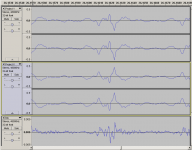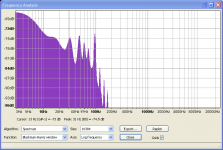I agree.
The primitive calcs were for steady state conditions (thermal equilibrium) with a small temp rise. To the best of my knowledge, under these conditions, thermal resistance (Rth) is a constant.
Thermal impulse calc, where thermal impedance (Zth) concept should be applied, is for knowledgeable guys.
Thanks for confirming.
You mean 700mA [(75mA * 8=600mA)+100mA]
And jacco is right and always serious, don’t be fooled by his clown emoticon!
George
Jacco, a gift (reimportation)
http://www.nxp.com/wcm_documents/models/bipolar-models/mextram/bctm04rth.pdf
No I mean 75mA, the 8 devices are 4 on the positive rail and 4 on the negative rail
Dejan, class A+ is the answer.
You're probably right, Pavel, but it's a bit expensive for me, assuming any reasonable power output.
Besides, I'm reasonably well taken care right now. I use the Marantz 170 DC power amp to move my bass drivers (rated at 85W/8, but they lie, it actually does 93W/8 inder the given condition) and one half (the power section) of a Marantz 1152 integrated amp (same construction, same PSU, but "only" 75W/8). Thank God, my Luxman C-03 preamp has two sets of output jacks.
Last edited:
I changed the quiescent current slightly to remove much of the crossover distortion and the system went completely out of balance. Mark asked me "What did you do with the high frequency response?" I said "nothing" but the highs had gone away. Months later when I visited, Mark added an electrostatic tweeter to restore the balance.
You made him adding electrostatic tweeters for nothing!

You made him adding electrostatic tweeters for nothing!
You didn't understand the problem and the solution: The amp used had crossover distortion. This adds higher frequencies. Once the crossover distortion was removed, the higher frequencies were gone. Balance needed to be restored so tweeters were added.
In case I get caught with my pants down, in flagrante,
Too late.
I saw the video from the hidden camera in the bank (you and Lebowski)
Oh, I see. He was right again ! Oh how much I….No I mean 75mA, the 8 devices are 4 on the positive rail and 4 on the negative rail
Clouseau: [answering the phone] This is Monsieur Gadoire - who is this speaking?
Dreyfus: Don't you know? HmmHmmm! Can't you guess? I'll give you a clue - this is the man who hates you. This is the man who more than anything else in the world would like to see you dead and buried!
Clouseau: ...are you the headwaiter that works in the little bistro on the Rue de Bazaar?
Dreyfus
You didn't understand the problem and the solution: The amp used had crossover distortion. This adds higher frequencies. Once the crossover distortion was removed, the higher frequencies were gone. Balance needed to be restored so tweeters were added.
Tattoo I understand the story and the problem Very well, It is you who didn`t understood my sense for humor... (English is obviously not my native language
He could just adjust back the quiescent current
Last edited:
Where I went astray was being sloppy in the testing, a fault we are all guilty of at times - as soon as I saw Mooly's posting I stopped reading forward, where most had already announced Y as the one. The PC had only been turned on shortly before, I was curious to see how subtle the difference was; downloaded, the speakers were switched on from dead cold immediately before the listening, none of the normal optimising of everything was done. A very marked difference was clear, and I just went with that ...Short term ABX testing is not the right tool to discriminate minor differences reliably, except in the hands of the very experienced listener.
I find it interesting that two of us here were able to correctly identify the 'loaded down' sound on minuscule laptop PC loudspeakers.
IOW, Franks 'famous' PC speakers are actually up to the task at hand.
Dan.
It all demonstrates that the level of seriousness that one applies to the exercise of testing for qualities is crucial - being casual about things can easily trip one up.
Tattoo I understand the story and the problem Very well, It is you who didn`t understood my sense for humor... (English is obviously not my native language)
He could just adjust back the quiescent current
But that would cause crossover distortion, something the designers did not want.
Frank generally does really well on these kind of tests, I've seen that before on the earlier runs. More than that, he knows what kind of sound he likes and I think would choose equipment based solely on its sonic merit rather than a spec sheet. I'm pretty much the same tbh. Its no good kidding yourself, if you don't like the sound it doesn't matter what the specs say.
Esperado had mentioned how valuation can change with differing circumstances. For example, the resistor may improve the sound or the opposite, depends on the whole circuit conditions (too bright a tweeter, etc).
For sonic, yes, the resistor will reduce it (but if your speaker is crossoverless and your amp is push-pull BJT, you don't suffer from missing a little current drive). But I think Frank mentioned about rich harmonics (and may be balance?) and more like music?. As long as the resistor is small enough ime there is possibility that it adds something good to the sound.
Jay, the real answer, as always, is to keep coming back to something if not sure, or one "gets it wrong". Long term consistency, as many are pointing out, is the real goal - and I never take anything seriously unless it's been heavily conditioned for an hour or two. Cheap gear especially needs a solid workout to bring it up to a reasonable state; I have been caught out already by the PC setup a number of times, by making a decision before it had properly stabilised.
Also, every person listens to the sound for different elements "being in place" - those who have worked professionally in the sound industry would frequently use very different criteria from what I do. It comes back to the best technique being to use recordings you know intimately, then you have reference points of knowing how well it can be reproduced, as your "measuring stick".
Also, every person listens to the sound for different elements "being in place" - those who have worked professionally in the sound industry would frequently use very different criteria from what I do. It comes back to the best technique being to use recordings you know intimately, then you have reference points of knowing how well it can be reproduced, as your "measuring stick".
Having looked very closely at the two files I can tell you they are almost identical. The differences are:I'm looking forward to that because I have no idea what Pano is going to show on this.
- Gain. A difference of about 0.02dB between the two files, maybe less
- Noise. What remains in the difference is mostly noise. Some hiss and some power mains noise. Pretty much what you would expect. Noise would not be correlated, so would remain as a difference.
Differences are 65 to 70dB down
- Frequency response
- Phase
- Harmonic structure
I think there were some lucky guesses. The files are just too similar for it to be anything but luck. Of course you won't believe me, but I would bet money on it.
Attached below is the spectrum of the difference between the 2 files. Look at the levels.
Attachments
Okay, I'm purely using Audacity, and there the files are most certainly not nulling to that degree, when perfectly aligned. For a start, at the very least, there are amplitude variations through the length of the track - an excellent nulling at one crescendo point means a strong crecendo in the difference file elsewhere in the track. If the software you're using is fudging, smoothing out the differences - where's the "truth"?
Okay, if people want to get a feel of what's really going on, in Audacity here's a time domain view of things:
Project Y is the unloaded
Project X is the loaded, aligned to Project Y, and inverted
Mix is as the term implies, effectively subtracting X from Y. If X were a perfect replica of Y, but only differing in amplitude then the waveform would look the "same". Note the scale on the left, the difference waveform is being shown at x100 zoom, meaning only 40dB down ...

Project Y is the unloaded
Project X is the loaded, aligned to Project Y, and inverted
Mix is as the term implies, effectively subtracting X from Y. If X were a perfect replica of Y, but only differing in amplitude then the waveform would look the "same". Note the scale on the left, the difference waveform is being shown at x100 zoom, meaning only 40dB down ...

- Status
- Not open for further replies.
- Home
- Member Areas
- The Lounge
- John Curl's Blowtorch preamplifier part II
